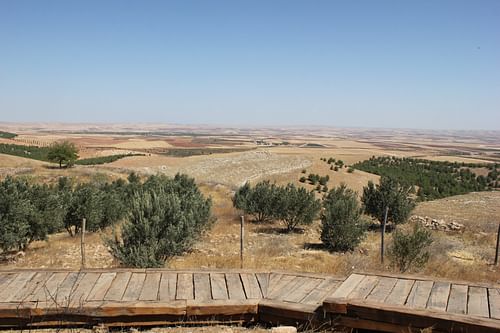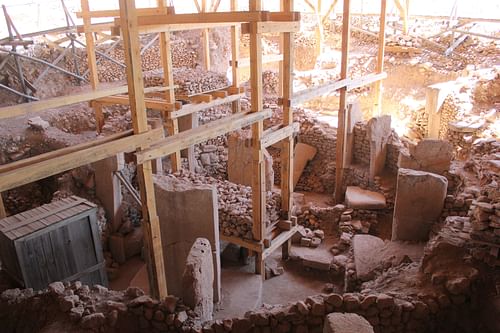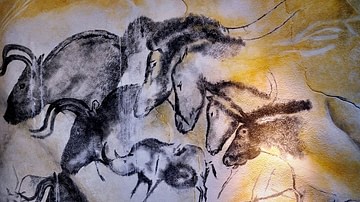Located in modern Turkey, Göbekli Tepe is one of the most important archaeological sites in the world. The discovery of this stunning 10,000 year old site in the 1990s CE sent shock waves through the archaeological world and beyond, with some researchers even claiming it was the site of the biblical Garden of Eden. The many examples of sculptures and megalithic architecture which make up what is perhaps the world's earliest temple at Göbekli Tepe predate pottery, metallurgy, the invention of writing, the wheel and the beginning of agriculture. The fact that hunter–gatherer peoples could organize the construction of such a complex site as far back as the 10th or 11th millennium BC not only revolutionizes our understanding of hunter-gatherer culture but poses a serious challenge to the conventional view of the rise of civilization.
A Description of the Göbekli Tepe Site
Göbekli Tepe (Turkish for the 'hill of the navel') is a 1000 foot diameter mound located at the highest point of a mountain ridge, around 9 miles northeast of the town of Şanlıurfa (Urfa) in southeastern Turkey. Since 1994 CE, excavations conducted by Klaus Schmidt of the Istanbul branch of the German Archaeological Institute, with the cooperation of the Şanlıurfa Museum, have been taking place at the site. Results to date have been astounding; especially bearing in mind the excavators estimate that their work has uncovered a mere 5% of the site.
Göbekli Tepe consists of four arrangements of monolithic pillars linked together by segments of coarsely built dry stone walls to form a series of circular or oval structures. There are two large pillars in the center of each complex which are encircled by slightly smaller stones facing inward. Archaeologists believe that these pillars could have once supported roofs. The structures vary in size between around 33 and 98 feet in diameter and have floors made of terrazzo (burnt lime).
The Megaliths at Göbekli Tepe
The megaliths themselves, 43 of which have been unearthed so far, are mainly T-shaped pillars of soft limestone up to around 16 feet in height, and were excavated and transported from a stone quarry on the lower southwestern slope of the hill. Geophysical surveys on the hill indicate that there are as many as 250 more megaliths lying buried around the site, suggesting that another 16 complexes once existed at Göbekli Tepe.
Although some of the standing stones at Göbekli Tepe are blank, others display extraordinary artwork in the form of elaborately carved foxes, lions, bulls, scorpions, snakes, wild boars, vultures, water fowl, insects, and arachnids. There are also abstract shapes and one relief of a naked woman, posed frontally in a sitting position. A number of the T-shaped stones have depictions of what appear to be arms at their sides, which could indicate that the stones represent stylized humans or perhaps gods. Although the pictograms at Göbekli Tepe do not represent a form of writing, they may have functioned as sacred symbols whose meanings were implicitly understood by local populations at the time.
The depictions of vultures at Göbekli Tepe have parallels at other Anatolian and Near Eastern sites. The walls of many of the shrines at the large Neolithic settlement of Çatal Höyük (in existence from approximately 7500 BCE to 5700 BCE) in south-central Turkey were adorned with large skeletal representations of vultures.
One theory put forward to explain the prominence of vultures in the early Anatolian Neolithic is in the context of possible excarnation practices suggesting a funerary cult. After death, bodies would have been deliberately left outside and exposed, perhaps on some kind of wooden frame, where their skeletons were stripped of flesh by vultures and other birds of prey. The skeletons would then be interred somewhere else. Perhaps the ritual of excarnation was the focus of a cult of the dead practiced by the inhabitants of Göbekli Tepe, as it certainly seems to have been elsewhere in Anatolia and the Near East in the Pre-Pottery Neolithic.
Curiously, Schmidt and his team have so far found no evidence of settlement at Göbekli Tepe - houses, cooking hearths, and refuse pits are all absent. The archaeologists did, however, find over 100,000 animal bone fragments, many of which exhibited cut marks and splintered edges which indicate that animals were being butchered and cooked somewhere in the area. The bones came from wild game such as gazelle (which accounted for over 60% of the bones), boar, sheep and red deer, and different species of birds such as vultures, cranes, ducks and geese. All of the bones were from wild species; evidence that that the people who inhabited Göbekli Tepe were hunter-gatherers rather than early farmers who kept domesticated animals.
Similar Sites in the Area
Due to the presence of multiple monumental complexes at such an early date Göbekli Tepe is a somewhat unique site. However, there are some parallels with the site at the early Neolithic settlement of Nevalı Çori, on the middle Euphrates River in Eastern Turkey, which lies only 12.5 north-west of Göbekli Tepe. The main temple at Nevalı Çori was dated to around 8,000 BCE, perhaps a thousand years later than Göbekli Tepe. The cult complexes at the settlement had a number of features in common with Göbekli Tepe, such as a terrazzo-style lime cement floor, monolithic T-shaped pillars built into dry stone walls, and two free-standing pillars in the center of the complex area. The T-shaped pillars show reliefs of what appear to be human hands. Unfortunately, Nevali Çori is now lost, submerged beneath a lake created by the Atatürk Dam in 1992 CE.
The excavators of Göbekli Tepe believe that around 8,000 BCE the people at the site deliberately buried the monuments under mountains of soil and settlement refuse, such as flints and animal bones, brought from elsewhere. This backfilling is the main reason why the site has been preserved after so many thousands of years. Why the inhabitants of Göbekli Tepe abandoned the site is not clearly understood, though the monuments had obviously lost their relevance, which may have had some connection with the new way of life which accompanied the development of agriculture and animal husbandry which occurred around this time.
An Organized Society?
The planning and building of such a site as Göbekli Tepe would have required a degree of organization and resources hitherto unknown in hunter-gatherer societies. Schmidt has made the intriguing suggestion that rather than building temples and other religious structures after they had learned to farm and live in settled communities, the hunter-gatherers of the area first constructed megalithic sites like Göbekli Tepe and thus laid the foundation for the later development of complex societies.
Indeed investigations of other sites surrounding Göbekli Tepe has revealed a prehistoric village just 20 miles away where evidence of the world's oldest domesticated strains of wheat has been recovered. According to radio carbon dates agriculture developed in the area around 10,500 years ago, just a few hundred years after the construction of Göbekli Tepe. Other sites in the region show evidence for the domestication of sheep, cattle and pigs animals 1,000 years after Göbekli Tepe's monuments were erected. All this evidence suggests that the area around Göbekli Tepe was at the forefront of the agricultural revolution.
Perhaps the most elusive aspect of the megalithic structures at Göbekli Tepe is their function – why did hunter-gatherers construct such elaborate monuments? In Schmidt's opinion, the site was an important location for a cult of the dead, and although no definite burials have been discovered so far, he believes they will be found underneath the floors of the circular monuments.
In the absence of houses or domestic buildings of any sort in the area, Schmidt sees Göbekli Tepe as akin to a pilgrimage destination which attracted worshipers from as far away as a hundred miles. Indeed the vast amount of animal bone discovered at the site certainly suggests that that ritual feasting (and even sacrifice) regularly took place here. There is perhaps a parallel here with the much later site at Durrington Walls, close to Stonehenge, in Wiltshire, England. Dating to around 2600 BCE Durrington Walls was a huge ritual timber circle where enormous amounts of animal bone, mainly pigs and cattle, were discovered, which suggested to its excavator Professor Mike Parker-Pearson that ritual feasting was an important feature of the site.
Intriguingly, in recent excavations at Göbekli Tepe Schmidt's team have uncovered pieces of human bones in soils which came from the niches behind the stone pillars at the site. Schmidt believes the bones show that corpses were brought into the ritual areas demarcated by the engraved T-shaped stone, where they were then laid out and left to be stripped of their soft tissue by wild animals. Such activity would Göbekli Tepe both a cemetery and a center of a regional death cult.
The Garden of Eden?
It is difficult to believe that the barren semi-desert where Göbekli Tepe is located was once a region of green meadows, woods, and fields of wild barley and wheat. The area would also have been thronging with vast herds of gazelle, flocks of geese and ducks. Indeed the animal and plant remains indicate such a rich and idyllic scene that Göbekli Tepe has been linked with the biblical story of the Garden of Eden. For those who take the story as a literal truth, the biblical location of Eden - at a point where four rivers descend, has been interpreted as within the Fertile Crescent.
The ancient Fertile Crescent is defined as an agriculturally rich region in Western Asia which consists of present-day Iraq, Syria, Lebanon, Israel, Kuwait, Jordan, south-eastern Turkey and west and south-western Iran. The four rivers of the biblical Eden include the Tigris and Euphrates, and believers in the connection between the two sites, such as the author David Rohl, point out that Göbekli Tepe lies between both of these. The Book of Genesis also states that Eden is ringed by mountains, as is Göbekli Tepe.
Other researchers believe that the Eden narrative in the Bible could be better interpreted as an allegory for the transition from a hunter-gather lifestyle to agriculture; though biblical accounts were recorded millennia after this transition took place. Interestingly, it is Klaus Schmidt's opinion that the shift from hunting to farming in the area brought about the decline of Göbekli Tepe. With the intense work required for agricultural societies to succeed there was no longer the time or perhaps the need for the monuments of Göbekli Tepe. In the surrounding area, trees were chopped down, soils became exhausted and the landscape was gradually transformed into the arid wilderness we see today.
Unfortunately, as the fame of Göbekli Tepe has spread art thieves and illegal antiquity dealers have been alerted. Around the end of September 2010 CE, a 1.3 foot-high, T-shaped stele decorated with a human head and an animal figure was stolen from the site. Since the theft, security at the site has been improved by installing a locking gate and a camera system; hopefully this will be enough to deter future thieves.
As long as only a tiny fraction of the incredible site of Göbekli Tepe has been excavated we can never know for sure why it was built and why it was buried and abandoned. Future work at the site will undoubtedly cast further light not only on these enigmas, but on our understanding of a critical stage in the development of human societies. One thing is certain - Göbekli Tepe has many more fascinating secrets to reveal.














